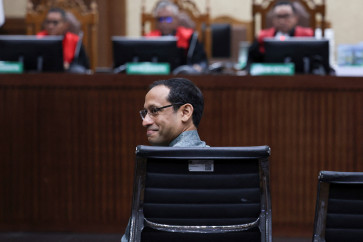Popular Reads
Top Results
Can't find what you're looking for?
View all search resultsPopular Reads
Top Results
Can't find what you're looking for?
View all search resultsAfrican-American step-dancing meets Balinese 'kecak'
(JP/Anggara Mahendra)Sanggar Cudamani is rehearsing a new dance in Pengosekan, but the drums and gongs in the group's thatch-roofed pavilion are silent
Change text size
Gift Premium Articles
to Anyone
 (JP/Anggara Mahendra)" height="333" border="0" width="500">(JP/Anggara Mahendra)
(JP/Anggara Mahendra)" height="333" border="0" width="500">(JP/Anggara Mahendra)Sanggar Cudamani is rehearsing a new dance in Pengosekan, but the drums and gongs in the groupâs thatch-roofed pavilion are silent.
The percussive beats that pulsate in the balmy night air are not made by musical instruments.
The dancers generate the complex interlocking rhythms with their bodies and voices.
âImagine taking away a drummerâs drums and putting the sound in your body instead,â says Khalid Freeman, an American dancer working with Cudamani in Bali while on break from his international tour with Cirque du Soleil.
âThatâs what body music is. My version bridges the gap between body percussion and hip-hop. I call it Khalid Greens. Itâs a word play on âcollard greensâ, which is soul food with great flavor when you know how to cook it.â
Freeman is collaborating with Sanggar Cudamani on a performance that combines the syncopated vocal chanting of kecak with the dynamic art of African-American step-dancing.
He demonstrates the moves to Cudamaniâs dancers with deft precision, rapidly slapping his hands against his thighs and chest as he stomps his feet in a rhythm that is contrapuntal to the sounds of his upper body.
The technique has links to the 19th century African-American slave tradition of âpatting jubaâ, which can be traced back to the African body slapping dance called giouba.
Scholars believe that the form flourished in America when slave-owners banned drums from their plantations for fear that their music could be used to signal insurrection. The slaves responded by communicating to one another with rhythms sounded out on their bodies instead of drums.
The tradition was kept alive by free black minstrel performers and African-American college fraternities. Now that the form has been featured in Hollywood films like Step Up and Stomp the Yard, step-dancing is entering the global mainstream of popular entertainment.
On Thursday evening, Freeman and Cudamani presented their new work at Ubudâs Betelnut stage to raise funds for the Rotary Club Bali Ubud Sunset, which supports local education and health projects.
The event was orchestrated by Rucina Ballinger after seeing Cudamani and Freeman perform last year at the International Body Music Festival in San Francisco.
âThe Cudamani kecak dancers picked up the American body music techniques so quickly,â said Ballinger, âthat I wanted to give them another chance to marry the formsâ.
Dewa Ayu Eka Putri is grateful for the opportunity to inhabit the dance steps of another culture.
âWorking with Khalid gives me a chance to discover another part of the world through dancing.â she says. The niece of Cudamaniâs founder Putu Dewa Berata, Ayu, joined the group in 1987 when she was 6 years old.
(JP/Anggara Mahendra) Sanggar Cudamani is rehearsing a new dance in Pengosekan, but the drums and gongs in the group's thatch-roofed pavilion are silent. The percussive beats that pulsate in the balmy night air are not made by musical instruments. The steps: Freeman and Cudamani perform at Betelnut, presenting the call and response technique that is part of the traditional African-American step-dance tradition. (JP/Ron Jenkins)
The dancers generate the complex interlocking rhythms with their bodies and voices.
'Imagine taking away a drummer's drums and putting the sound in your body instead,' says Khalid Freeman, an American dancer working with Cudamani in Bali while on break from his international tour with Cirque du Soleil.
'That's what body music is. My version bridges the gap between body percussion and hip-hop. I call it Khalid Greens. It's a word play on 'collard greens', which is soul food with great flavor when you know how to cook it.'
Freeman is collaborating with Sanggar Cudamani on a performance that combines the syncopated vocal chanting of kecak with the dynamic art of African-American step-dancing.
He demonstrates the moves to Cudamani's dancers with deft precision, rapidly slapping his hands against his thighs and chest as he stomps his feet in a rhythm that is contrapuntal to the sounds of his upper body.
The technique has links to the 19th century African-American slave tradition of 'patting juba', which can be traced back to the African body slapping dance called giouba.
Scholars believe that the form flourished in America when slave-owners banned drums from their plantations for fear that their music could be used to signal insurrection. The slaves responded by communicating to one another with rhythms sounded out on their bodies instead of drums.
The tradition was kept alive by free black minstrel performers and African-American college fraternities. Now that the form has been featured in Hollywood films like Step Up and Stomp the Yard, step-dancing is entering the global mainstream of popular entertainment.
On Thursday evening, Freeman and Cudamani presented their new work at Ubud's Betelnut stage to raise funds for the Rotary Club Bali Ubud Sunset, which supports local education and health projects.
The event was orchestrated by Rucina Ballinger after seeing Cudamani and Freeman perform last year at the International Body Music Festival in San Francisco.
'The Cudamani kecak dancers picked up the American body music techniques so quickly,' said Ballinger, 'that I wanted to give them another chance to marry the forms'.
Dewa Ayu Eka Putri is grateful for the opportunity to inhabit the dance steps of another culture.
'Working with Khalid gives me a chance to discover another part of the world through dancing.' she says. The niece of Cudamani's founder Putu Dewa Berata, Ayu, joined the group in 1987 when she was 6 years old.
'I started out playing the drums,' Ayu explains. 'Maybe that is why I can learn the American body music techniques so quickly. When I hear the rhythms of Khalid's body music I feel them internally like a drummer does, and then it is easy to play them on my body.'
Ayu connects the positive energy she feels when performing American body music to the exhilaration of performing Balinese kecak chants.
'The feeling starts with your breath,' she says, demonstrating the sharp percussive sounds of kecak.
'You can't be lazy. You have to breathe with an intensity that matches the intensity of your body movements. That's why when Walter Spies came to Bali in the 1930s, he saw that villages where this kind of chanting was performed were cured of diseases. The deep breathing brings good health and the strong exhalation expels whatever is troubling the body.'
When Ayu refers to the German artist Walter Spies, she is recalling the origins of kecak chanting as an accompaniment to sacred trance dances linked to ritual healing ceremonies.
Spies worked with Balinese dancers to reshape these ceremonial chants into a spectacle for tourists that helped villagers generate income.
Step-dancing has undergone similar cross-cultural transformations as it was passed on from its sacred roots in African ritual to African-American slaves to college students in black fraternities to Hollywood, where some fear it is in danger of being appropriated as a commercial commodity.
The collaboration between Freeman and Cudamani continues the cross-pollination of art forms across national boundaries. Freeman hopes to create more work with Balinese artists.
'It's one thing to read about another culture in a book,' he says while the Cudamani dancers gather around a cell phone to watch a YouTube clip of a college step-dance competition in America.
'But it's something else to be here in Bali experiencing the dance in a hut with crickets all around us. There is nothing in the world like making your own music with your own body together with other people. And there is so much foliage. Home in Las Vegas you can't even water the grass, but here everything is so green and fertile. The possibilities are endless.'
Your Opinion Matters
Share your experiences, suggestions, and any issues you've encountered on The Jakarta Post. We're here to listen.
Thank You
Thank you for sharing your thoughts. We appreciate your feedback.
Share options
Quickly share this news with your network—keep everyone informed with just a single click!
Gift Premium Articles
to Anyone
Share the best of The Jakarta Post with friends, family, or colleagues. As a subscriber, you can gift 3 to 5 articles each month that anyone can read—no subscription needed!
Continue in the app
Get the best experience—faster access, exclusive features, and a seamless way to stay updated.










